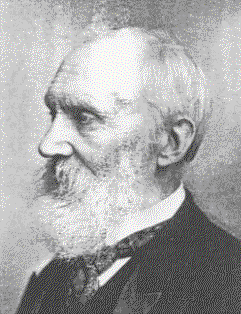

(1824 - 1907)
Born on 26 June 1824 in Belfast , Ireland, William Thomson became one of the leading physical scientists and greatest teachers of his time. His family were committed to liberal political reform and personal advancement. Both he and his elder brother James Thomson (1822-1892), who also became a prominent physicist, were educated at home by their father.
In 1832, Thomson's father took up the post of Professor of mathematics at Glasgow University . Thomson himself entered the University two years later at the age of ten to study Natural Philosophy (Science). He was elected to the position of Professor of Natural Philosophy at the University of Glasgow, at the age of 22, where he created the first physics laboratory in a British University. He spent most of his life there.
Thomson patented 70 inventions and published 661 papers in all, the first of which was at the age of 16. He did important research in Thermodynamics , investigating the interrelation of heat and mechanical energy. Over the years, Thomson collaborated with British physicist James Prescott Joule ; Joule's experimental prowess matched Thomson's theoretical ability. In 1852 they discovered the Joule-Thomson cooling effect , which causes gases to undergo a fall in temperature as they expand through a nozzle.
Thomson's mirror galvonometer, used in
the first transatlantic telegraph cable linking Ireland with
Canada.
In 1848, Thomson proposed the
absolute
scale of temperature.
In 1851 he published the paper "On the dynamical theory of heat",
and also that year was elected to the Royal Society.
He was also interested in the age of the sun and the earth and
calculated values for each. He designed many new
devices, including the
mirror-galvonometer
which was used in the first successful
transatlantic telegraph cable
, in 1866. Thomson often risked his life while
supervising the laying of such cables. In 1870, after buying a large yacht, Thomson
became interested in problems of navigation. He designed a new
improved compass, consisting of eight narrow steel needles
suspended from a light aluminium ring under a thin circular card.
In 1882, it was adopted by all British navy vessels. He was knighted in 1866 by
Queen Victoria
as
Lord Kelvin, for his work. Among his many honours were the Royal
Society's
Copley medal
in 1883, the Presidency of the
Royal Society
from 1890 to 1894, and the Order of Merit in 1902.
His legacy is remembered today in the
SI unit
for temperature,
Kelvin (K)
. The Thomson
compass.
He is also known for an address given to an
assemblage of physicists at the
British Association for the
Advancement of Science
in 1900 in which he stated,
"There is nothing new to be discovered in physics now.
All that remains is more and more precise measurement." Thomson retired from his chair at Glasgow in
1899. After a long and fruitful career he died at his home in
Largs
, Ayrshire, Scotland on 17 December 1907.
He was buried at Westminister Abbey,London. There is a
Crater Thomson
on the moon. There was a statue erected in his honour at the
Botanic Gardens, Belfast in 1913. Here are some famous skeptical quotes
by William Thomson "Heavier-than-air flying machines are
impossible" "Radio has no future" "X-rays are a hoax" 
Awards:

Later life:
![]()
![]()
![]()